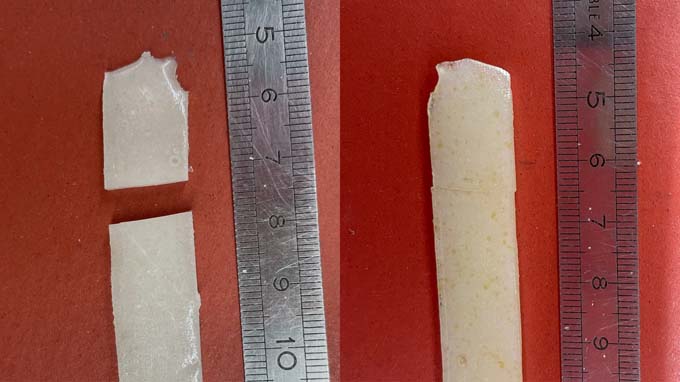New epoxy resin combines flame retardancy and recyclability
Researchers at Empa have developed a new type of epoxy resin: On the one hand, it is flame retardant and mechanically resistant, but on the other hand, it can also be recycled - rather unusual for so-called duromers. The new plastic can be used, for example, for floor coatings or in composite materials for trains and aircraft.

In combination with glass or carbon fibers, epoxy resins are used, for example, to manufacture components for aircraft, cars, trains, ships and wind turbines. Such fiber-reinforced epoxy-based plastics have excellent mechanical and thermal properties and are much lighter than metal. Alongside these many advantages, they have one decisive disadvantage: they are not recyclable - at least not yet.
Limits of recyclability
Empa researchers led by Sabyasachi Gaan have now succeeded in developing an epoxy resin-based plastic. This is said to be fully recyclable, repairable and also flame retardant, as reported in a paper published in the journal Chemical Engineering Journal published article is called. What's more, the favorable thermomechanical properties of epoxy resins are also still guaranteed.
Why is the recyclability of epoxy resins so difficult? Epoxy resins are so-called duromers. This type of plastic consists of closely interlinked polymer chains. These chemical bonds make melting impossible. Once the plastic has cured, it can no longer be deformed. Such duromers contrast with thermoplastics such as PET or polyolefins. Their polymer chains are close together but not bonded. Under the influence of heat, these plastics can be melted and formed into new shapes. However, because of the lack of crosslinking, their mechanical properties at elevated temperatures are generally not as advantageous as those of duromers.
A new type of plastic
The new plastic developed by Empa researchers is actually a duromer. What is new about it, however, is its meltability. This is due to a special functional molecule from the class of phosphonic acid esters. This was introduced into the matrix of the epoxy resin. "We originally synthesized this molecule as a flame retardant," says Empa scientist Wenyu Wu Klingler, who co-invented the technology. However, the bond that the molecule forms with the polymer chains of the epoxy resin is reversible, meaning it can be released under certain conditions. This loosens the crosslinking of the polymer chains so that they can be melted and shaped.
Such materials, also known as vitrimers, have only been known for about ten years and are considered particularly promising. "Today, fiber-reinforced plastics are virtually impossible to recycle, except under extreme conditions that damage the fibers," explains Wu Klingler. "Once they have reached the end of their useful life, they are incinerated or disposed of in landfills. With our plastic, it would be possible for the first time to put them back into the material cycle." Their vision for the future, adds group leader Sabyasachi Gaan, is "a composite material in which the fibers and the plastic matrix can be completely separated and reused." The researcher sees a particular advantage, for example, in carbon-fiber-reinforced plastics, such as those used in the construction of airplanes, trains, boats, cars, bicycles and more. "The production of carbon fibers requires a lot of energy and releases an enormous amount of CO2," he explains. "If we could recycle them, their environmental footprint would be a lot better - and the price a lot lower." In addition, valuable additives such as phosphorus could also be recovered from the polymer matrix in this way.
Customized material
Fiber-reinforced plastics are not the only application for the new epoxy resin. The plastic could also be used for coating wooden floors. There, it could serve as a transparent layer that is flame-retardant on the one hand, but "healable" under the influence of pressure and heat on the other: scratches or other damage could thus be repaired. "We didn't develop a single material for a specific purpose, but rather a toolbox," Gaan explains. "The flame retardancy, recyclability and repairability are all there. We can optimize all other properties depending on the intended use." For example, he says, tile properties are particularly important for the production of fiber-reinforced plastics, while exterior wood coatings must also be weather-resistant.

To pursue these and other applications of the material, the researchers are now looking for industrial partners. The researchers believe that the chances of commercial success are good: the modified epoxy resin is inexpensive and easy to manufacture.
Source: Empa









